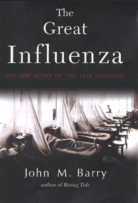The Great Influenza: The Epic Story of the Deadliest Plague In History
Viking Books, February 2004.
Hardcover, 546 pages.
ISBN: 0670894737
 The recent SARS, influenza and bird flu outbreaks led to a few news
stories reminding people of the incredible and deadly influenza
outbreak of 1918. Even with these recent news reminders, few people are
aware of how violent the disease was and how
vulnerable the killer epidemic made people feel across our entire
world. It started with soldiers, killing thousands and thousands
of individual soldiers at bases in the United States. Doctors were completely
unable to stop or slow its spread; the killer flu eventually traveled to the
general population and worked its way from East to West across the
United States. The influenza spread so fast that hospitals and morgues
were quickly overrun. People were often forced to live with the dead bodies
of family members because there were so many dead and dying that
the health system and city morgues were completely overwhelmed.
Many health workers were also sick and dying themselves. Coffins quickly
became unavailable and bodies were stacked up on porches and next to houses.
Symptoms of the disease were terrifying and violent: incredible pain,
blood pouring from noses and eyes, intense fever,
headache, weakness, body aches and delirium. People often died after
gasping for breath for hours trying to clear a red, frothy liquid from
their lungs. Mayors in cities lied to their citizens and said the plague
would not come. But it came and even during the
epidemic many newspapers reported that there was no cause for alarm or
told people the virus had peaked when it had not. In 1918, influenza was
a killing machine that raged from coast to coast, killing over 600,000
Americans. In October, 1918 influenza killed 195,000
Americans in a single month. Estimates for those killed by the disease
worldwide range from 50 to 100 million. Today, we have the CDC and
the WHO, which provide invaluable monitoring of emerging diseases.
These are great steps but even so, disease experts insist the next
outbreak is not a matter of if, but when.
The recent SARS, influenza and bird flu outbreaks led to a few news
stories reminding people of the incredible and deadly influenza
outbreak of 1918. Even with these recent news reminders, few people are
aware of how violent the disease was and how
vulnerable the killer epidemic made people feel across our entire
world. It started with soldiers, killing thousands and thousands
of individual soldiers at bases in the United States. Doctors were completely
unable to stop or slow its spread; the killer flu eventually traveled to the
general population and worked its way from East to West across the
United States. The influenza spread so fast that hospitals and morgues
were quickly overrun. People were often forced to live with the dead bodies
of family members because there were so many dead and dying that
the health system and city morgues were completely overwhelmed.
Many health workers were also sick and dying themselves. Coffins quickly
became unavailable and bodies were stacked up on porches and next to houses.
Symptoms of the disease were terrifying and violent: incredible pain,
blood pouring from noses and eyes, intense fever,
headache, weakness, body aches and delirium. People often died after
gasping for breath for hours trying to clear a red, frothy liquid from
their lungs. Mayors in cities lied to their citizens and said the plague
would not come. But it came and even during the
epidemic many newspapers reported that there was no cause for alarm or
told people the virus had peaked when it had not. In 1918, influenza was
a killing machine that raged from coast to coast, killing over 600,000
Americans. In October, 1918 influenza killed 195,000
Americans in a single month. Estimates for those killed by the disease
worldwide range from 50 to 100 million. Today, we have the CDC and
the WHO, which provide invaluable monitoring of emerging diseases.
These are great steps but even so, disease experts insist the next
outbreak is not a matter of if, but when.
John Barry has done an incredible job of not only accounting for the horrible and tragic occurrences during the plague, but also the triumphs and survival of humanity. Barry describes the time's warlike political environment under President Woodrow Wilson and how the sending of men off to war actually helped spread the disease around the globe. Soldiers would often die on ships before reaching their destinations. Barry also details the incredible advances that had been made in science leading up to the plague and gives biological insight into diseases, especially influenza. Despite these advances, mankind was completely unprepared for the deadly outbreak. There are so many fascinating details about the outbreak, as it affected soldiers, cities, doctors, families and individuals, that readers will find new anecdotes and information from start to finish. This book is a great read for anyone interested in politics or medicine, or who is interested in how America and the world survived its toughest year. The Great Influenza is an incredible story that must never be forgotten.
--Greg Knollenberg
The Great Influenza: The Epic Story of the Deadliest Plague In History is available for purchase on Amazon.com
Note: We may receive a commission from sales made through product links in this article.
This review was published in the May-June, 2004 of The Internet Writing Journal.
Copyright © Writers Write, Inc. All Rights Reserved.
